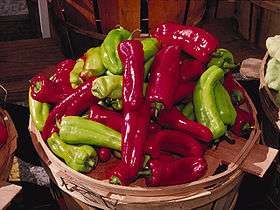Capsicum
| Capsicum | |
|---|---|
 | |
| Red bell pepper fruit and longitudinal section | |
| Scientific classification | |
| Kingdom: | Plantae |
| (unranked): | Angiosperms |
| (unranked): | Eudicots |
| (unranked): | Asterids |
| Order: | Solanales |
| Family: | Solanaceae |
| Subfamily: | Solanoideae |
| Tribe: | Capsiceae |
| Genus: | Capsicum L.[1] |
| Species | |
Capsicum /ˈkæpsᵻkəm/[3] (also known as peppers) is a genus of flowering plants in the nightshade family Solanaceae. Its species are native to the Americas, where they have been cultivated for thousands of years. Following the Columbian Exchange, it has become cultivated worldwide, and it has also become a key element in many cuisines. In addition to use as spices and food vegetables, Capsicum species have also been used as medicines and lachrymatory agents.
Etymology and names
The generic name may come from Latin capsa 'box', presumably alluding to the pods or the Greek word κάπτω kapto 'to gulp'.[4][5][6] The name "pepper" comes from the similarity of the flavor to black pepper, Piper nigrum, although there is no botanical relationship with it or with Sichuan pepper. The original term, chilli (now chile in Mexico) came from the Nahuatl word chilli, denoting a larger Capsicum variety cultivated at least since 3000 BC, as evidenced by remains found in pottery from Puebla and Oaxaca.[7]
The fruit of Capsicum plants have a variety of names depending on place and type. The piquant (spicy) varieties are commonly called chili peppers, or simply "chillies". The large, mild form is called red pepper, green pepper, or bell pepper in North America and United Kingdom and typically "capsicum" in New Zealand,[8] Australia, Singapore and India. The fruit is called paprika in some other countries (although paprika can also refer to the powdered spice made from various capsicum fruit).
Growing conditions
Ideal growing conditions for peppers include a sunny position with warm, loamy soil, ideally 21 to 29 °C (70 to 84 °F), that is moist but not waterlogged.[9] Extremely moist soils can cause seedlings to "damp-off" and reduce germination.
The plants are sensitive to frost.[10] For flowering, Capsicum are a non-photoperiod-sensitive crop. The flowers can self-pollinate. However, at extremely high temperature, 92 to 100 °F (33 to 38 °C), pollen loses viability, and flowers are much less likely to pollinate successfully.
Species and varieties
Capsicum consists of 20–27 species,[11] five of which are domesticated: C. annuum, C. baccatum, C. chinense, C. frutescens, and C. pubescens.[12] Phylogenetic relationships between species have been investigated using biogeographical,[13] morphological,[14] chemosystematic,[15] hybridization,[16] and genetic[11] data. Fruits of Capsicum can vary tremendously in color, shape, and size both between and within species, which has led to confusion over the relationships among taxa.[17] Chemosystematic studies helped distinguish the difference between varieties and species. For example, C. baccatum var. baccatum had the same flavonoids as C. baccatum var. pendulum, which led researchers to believe the two groups belonged to the same species.[15]
Many varieties of the same species can be used in many different ways; for example, C. annuum includes the "bell pepper" variety, which is sold in both its immature green state and its red, yellow, or orange ripe state. This same species has other varieties, as well, such as the Anaheim chiles often used for stuffing, the dried ancho (also sometimes referred to as poblano) chile used to make chili powder, the mild-to-hot jalapeño, and the smoked, ripe jalapeño, known as chipotle.
Peru is thought to be the country with the highest cultivated Capsicum diversity since varieties of all five domesticates are commonly sold in markets in contrast to other countries. Bolivia is considered to be the country where the largest diversity of wild Capsicum peppers are consumed. Bolivian consumers distinguish two basic forms: ulupicas, species with small round fruits including C. eximium, C. cardenasii, C. eshbaughii, and C. caballeroi landraces; and arivivis, with small elongated fruits including C. baccatum var. baccatum and C. chacoense varieties.[18]
Most of the capsaicin in a pungent (hot) pepper is concentrated in blisters on the epidermis of the interior ribs (septa) that divide the chambers, or locules, of the fruit to which the seeds are attached.[19] A study on capsaicin production in fruits of C. chinense showed that capsaicinoids are produced only in the epidermal cells of the interlocular septa of pungent fruits, that blister formation only occurs as a result of capsaicinoid accumulation, and that pungency and blister formation are controlled by a single locus, Pun1, for which there exist at least two recessive alleles that result in non-pungency of C. chinense fruits.[20]
The amount of capsaicin in hot peppers varies significantly among varieties, and is measured in Scoville heat units (SHU). The world's current hottest known pepper as rated in SHU is the 'Carolina Reaper,' which had been measured at over 2,200,000 SHU.
Species list[21][22]
- Capsicum annuum L.
- Capsicum baccatum L.
- Capsicum buforum Hunz.
- Capsicum campylopodium Sendtn.
- Capsicum cardenasii Heiser & P. G. Sm.
- Capsicum ceratocalyx M.Nee
- Capsicum chacoense Hunz.
- Capsicum chinense Jacq.
- Capsicum coccineum (Rusby) Hunz.
- Capsicum cornutum (Hiern) Hunz.
- Capsicum dimorphum (Miers) Kuntze
- Capsicum dusenii Bitter
- Capsicum eximium Hunz.
- Capsicum flexuosum Sendtn.
- Capsicum friburgense Bianch. & Barboza
- Capsicum frutescens L.
- Capsicum galapagoense Hunz.
- Capsicum geminifolium (Dammer) Hunz.
- Capsicum havanense Kunth
- Capsicum hookerianum (Miers) Kuntze
- Capsicum hunzikerianum Barboza & Bianch.
- Capsicum lanceolatum (Greenm.) C.V.Morton & Standl.
- Capsicum leptopodum (Dunal) Kuntze
- Capsicum lycianthoides Bitter
- Capsicum minutiflorum (Rusby) Hunz.
- Capsicum mirabile Mart. ex Sendtn.
- Capsicum mositicum Toledo
- Capsicum parvifolium Sendtn.
- Capsicum pereirae Barboza & Bianch.
- Capsicum pubescens Ruiz & Pav.
- Capsicum ramosissimum Witasek
- Capsicum recurvatum Witasek
- Capsicum rhomboideum (Dunal) Kuntze
- Capsicum schottianum Sendtn.
- Capsicum scolnikianum Hunz.
- Capsicum spina-alba (Dunal) Kuntze
- Capsicum stramoniifolium (Kunth) Standl.
- Capsicum tovarii Eshbaugh et al.
- Capsicum villosum Sendtn.
Formerly placed here
- Tubocapsicum anomalum (Franch. & Sav.) Makino (as C. anomalum Franch. & Sav.)
- Vassobia fasciculata (Miers) Hunz. (as C. grandiflorum Kuntze)
- Witheringia stramoniifolia Kunth (as C. stramoniifolium (Kunth) Kuntze)[2]
Genetics
Most Capsicum species are 2n=2x=24. A few of the non-domesticated species are 2n=2x=32.[23] All are diploid. The Capsicum annuum and Capsicum chinense genomes were completed in 2014. The Capsicum annuum genome is approximately 3.48 Gb, making it larger than the human genome. Over 75% of the pepper genome is composed of transposable elements, mostly Gypsy elements, distributed widely throughout the genome. The distribution of transposable elements is inversely correlated with gene density. Pepper is predicted to have 34,903 genes, approximately the same number as both tomato and potato, two related species within the Solanaceae family.[24]
Breeding
Many types of peppers have been bred for heat, size, and yield. Along with selection of specific fruit traits such as flavor and color, specific pest, disease and abiotic stress resistances are continually being selected. Breeding occurs in several environments dependent on the use of the final variety including but not limited to: conventional, organic, hydroponic, green house and shade house production environments.
Several breeding programs are being conducted by corporations and universities. In the United States, New Mexico State University has released several varieties in the last few years.[25] Cornell University has worked to develop regionally adapted varieties that work better in cooler, damper climates. Other universities such as UC Davis, University of Wisconsin-Madison, and Oregon State University have smaller breeding programs. Many vegetable seed companies breed different types of peppers as well.
Production

In 2013, global production of both green and dried chili pepper was 34.6 million tonnes, with 47% of output coming from China alone.[26] India was the top producer of dry peppers, producing 1.4 million tonnes.
Worldwide pepper production
| Country | Production (million tonnes) |
|---|---|
Nutrition
Peppers are highly nutritious. They have more Vitamin C than an orange, and a typical bell pepper contains more than 100% of the daily recommended value for Vitamin C. They also have relatively high amounts of Vitamin B6. Fresh fruit is 94% water. Dried pepper fruit has a much different nutritional value due to the dehydration and concentration of vitamins and minerals.
| Nutritional value per 100 g (3.5 oz) | |
|---|---|
| Energy | 20 kcal |
| Carbohydrates | 4.64 g |
| Sugars | 2.40 g |
| Dietary fiber | 1.7 g |
| Fat | 0.17 g |
| Protein | 0.86 g |
| Vitamins | |
| Vitamin C | (>100%) 80.4 mg |
| Thiamine (B1) | (5%) 0.057 mg |
| Riboflavin (B2) | (2%) 0.028 mg |
| Niacin (B3) | (3%) 0.480 mg |
| Vitamin B6 | (16%) 0.224 mg |
| Folate (B9) | (3%) 10 μg |
| Vitamin A | (2%) 18 μg |
| Vitamin E | (2%) 0.37 mg |
| Vitamin K | (7%) 7.4μg |
| Minerals | |
| Calcium | (1%) 10 mg |
| Iron | (3%) 0.34 mg |
| Magnesium | (3%) 10 mg |
| Phosphorus | (3%) 20 mg |
| Potassium | (3%) 175 mg |
| Sodium | (3%) 3 mg |
| Zinc | (2%) 0.13 mg |
|
| |
| |
| Percentages are roughly approximated using US recommendations for adults.
Source: USDA Nutrient Database | |
Capsaicin in Capsicum
The fruit of most species of Capsicum contains capsaicin (methyl-n-vanillyl nonenamide), a lipophilic chemical that can produce a strong burning sensation (pungency or spiciness) in the mouth of the unaccustomed eater. Most mammals find this unpleasant, whereas birds are unaffected.[27][28] The secretion of capsaicin protects the fruit from consumption by insects[29] and mammals, while the bright colors attract birds that will disperse the seeds.
Capsaicin is present in large quantities in the placental tissue (which holds the seeds), the internal membranes, and to a lesser extent, the other fleshy parts of the fruits of plants in this genus. The seeds themselves do not produce any capsaicin, although the highest concentration of capsaicin can be found in the white pith around the seeds.[30]
The amount of capsaicin in the fruit is highly variable and dependent on genetics and environment, giving almost all types of Capsicum varied amounts of perceived heat. The most recognizable Capsicum without capsaicin is the bell pepper,[31] a cultivar of Capsicum annuum, which has a zero rating on the Scoville scale. The lack of capsaicin in bell peppers is due to a recessive gene that eliminates capsaicin and, consequently, the "hot" taste usually associated with the rest of the Capsicum family.[32] There are also other peppers without capsaicin, mostly within the Capsicum annuum species, such as the cultivars Giant Marconi,[33] Yummy Sweets,[34] Jimmy Nardello,[35] and Italian Frying peppers[36](also known as the Cubanelle).
Chili peppers are of great importance in Native American medicine, and capsaicin is used in modern medicine—mainly in topical medications—as a circulatory stimulant and analgesic. In more recent times, an aerosol extract of capsaicin, usually known as capsicum or pepper spray, has become used by law enforcement as a nonlethal means of incapacitating a person, and in a more widely dispersed form for riot control, or by individuals for personal defense. Pepper in vegetable oils, or as an horticultural product[37] can be used in gardening as a natural insecticide.
Although black pepper causes a similar burning sensation, it is caused by a different substance—piperine.
Cuisine
Capsicum fruits and peppers can be eaten raw or cooked. Those used in cooking are generally varieties of the C. annuum and C. frutescens species, though a few others are used, as well. They are suitable for stuffing with fillings such as cheese, meat, or rice.
They are also frequently used both chopped and raw in salads, or cooked in stir-fries or other mixed dishes. They can be sliced into strips and fried, roasted whole or in pieces, or chopped and incorporated into salsas or other sauces, of which they are often a main ingredient.
They can be preserved in the form of a jam,[38] or by drying, pickling, or freezing. Dried peppers may be reconstituted whole, or processed into flakes or powders. Pickled or marinated peppers are frequently added to sandwiches or salads. Frozen peppers are used in stews, soups, and salsas. Extracts can be made and incorporated into hot sauces.
The Spanish conquistadores soon became aware of their culinary properties, and brought them back to Europe, together with cocoa, potatoes, sweet potatoes, tobacco, maize, beans, and turkeys. They also brought it to the Spanish Philippines colonies, whence it spread to Asia. The Portuguese brought them to their African and Asiatic possessions such as India.
All the varieties were appreciated, but the hot ones are particularly appreciated because they can enliven otherwise monotonous diets. This was of some importance during dietary restrictions for religious reasons, such as Lent in Christian countries.
Spanish cuisine soon benefited from the discovery of chiles in the New World, and it would become very difficult to untangle Spanish cooking from chiles. Ground chiles, or paprika, hot or otherwise, are a key ingredient in chorizo, which is then called picante (if hot chile is added) or dulce (if otherwise). Paprika is also an important ingredient in rice dishes, and plays a definitive role in squid Galician style (polbo á feira). Chopped chiles are used in fish or lamb dishes such as ajoarriero or chilindrón. Pisto is a vegetarian stew with chilies and zucchini as main ingredients. They can also be added, finely chopped, to gazpacho as a garnish. In some regions, bacon is salted and dusted in paprika for preservation. Cheese can also be rubbed with paprika to lend it flavour and colour. Dried round chiles called ñoras are used for arroz a banda.
According to Richard Pankhurst, C. frutescens (known as barbaré) was so important to the national cuisine of Ethiopia, at least as early as the 19th century, "that it was cultivated extensively in the warmer areas wherever the soil was suitable." Although it was grown in every province, barbaré was especially extensive in Yejju, "which supplied much of Showa, as well as other neighbouring provinces." He mentions the upper Golima River valley as being almost entirely devoted to the cultivation of this plant, where it was harvested year-round.[39]
In 2005, a poll of 2,000 people revealed the pepper to be Britain's fourth-favourite culinary vegetable.[40]
In Hungary, sweet yellow peppers – along with tomatoes – are the main ingredient of lecsó.
In Bulgaria, South Serbia, and Macedonia, peppers are very popular, too. They can be eaten in salads, like shopska salata; fried and then covered with a dip of tomato paste, onions, garlic, and parsley; or stuffed with a variety of products, such as minced meat and rice, beans, or cottage cheese and eggs. Peppers are also the main ingredient in the traditional tomato and pepper dip lyutenitsa and ajvar. They are in the base of different kinds of pickled vegetables dishes, turshiya.
Peppers are also used widely in Italian cuisine, and the hot species are used all around the southern part of Italy as a common spice (sometimes served with olive oil). Capsicum peppers are used in many dishes; they can be cooked by themselves in a variety of ways (roasted, fried, deep-fried) and are a fundamental ingredient for some delicatessen specialities, such as nduja.
Capsicums are also used extensively in Sri Lankan cuisine as side dishes.[41]
The Maya and Aztec people of Mesoamerica used Capsicum fruit in cocoa drinks as a flavouring.[42]
GRAS
Only Capsicum frutescens L. and Capsicum annuum L. are GRAS.[43][44]
Synonyms and common names
The name given to the Capsicum fruits varies between English-speaking countries.
In Australia, New Zealand, and India, heatless varieties are called "capsicums", while hot ones are called "chilli"/"chillies" (double L). Pepperoncini are also known as "sweet capsicum". The term "bell peppers" is almost never used, although C. annuum and other varieties which have a bell shape and are fairly hot, are often called "bell chillies".
In Ireland and the United Kingdom, the heatless varieties are commonly known simply as "peppers" (or more specifically "green peppers", "red peppers", etc.), while the hot ones are "chilli"/"chillies" (double L) or "chilli peppers".
In the United States and Canada, the common heatless varieties are referred to as "bell peppers", "sweet peppers", "red/green/etc. peppers", or simply "peppers", additionally in Indiana they may be referred to as "mangoes/mango peppers", while the hot varieties are collectively called "chile"/"chiles", "chili"/"chilies", or "chili"/"chile peppers" (one L only), "hot peppers", or named as a specific variety (e.g., banana pepper).
In Polish and in Hungarian, the term papryka and paprika (respectively) is used for all kinds of capsicums (the sweet vegetable, and the hot spicy), as well as for dried and ground spice made from them (named paprika in both U.S. English and Commonwealth English). Also, fruit and spice can be attributed as papryka ostra (hot pepper) or papryka słodka (sweet pepper). The term pieprz (pepper) instead means only grains or ground black pepper (incl. the green, white, and red forms), but not capsicum. Sometimes, the hot capsicum spice is also called chilli.
In Italy and the Italian- and German-speaking parts of Switzerland, the sweet varieties are called peperone and the hot varieties peperoncino (literally "small pepper"). In Germany, the heatless varieties as well as the spice are called Paprika and the hot types are primarily called Peperoni or Chili while in Austria, Pfefferoni is more common for these; in Dutch, this word is also used exclusively for bell peppers, whereas chilli is reserved for powders, and hot pepper variants are referred to as Spaanse pepers (Spanish peppers). In Switzerland, though, the condiment powder made from capsicum is called Paprika (German language regions) and paprica (French and Italian language region). In French, capsicum is called poivron.
In Spanish-speaking countries, many different names are used for the varieties and preparations. In Mexico, the term chile is used for "hot peppers", while the heatless varieties are called pimiento (the masculine form of the word for pepper, which is pimienta). Several other countries, such as Chile, whose name is unrelated, Perú, Puerto Rico, and Argentina, use ají. In Spain, heatless varieties are called pimiento and hot varieties guindilla. Also, in Argentina and Spain, the variety C. chacoense is commonly known as "putaparió", a slang expression equivalent to "damn it", probably due to its extra-hot flavour. In Indian English, the word "capsicum" is used exclusively for Capsicum annuum. All other varieties of hot capsicum are called chilli. In northern India and Pakistan, C. annuum is also commonly called shimla mirch in the local language and as "Kodai Mozhagai" in Tamil which roughly translates to "umbrella chilli" due to its appearance. Shimla, incidentally, is a popular hill-station in India (and mirch means chilli in local languages).
In Japanese, tōgarashi (唐辛子, トウガラシ "Chinese mustard") refers to hot chili peppers, and particularly a spicy powder made from them which is used as a condiment, while bell peppers are called pīman (ピーマン, from the French piment or the Spanish pimiento).
Pictures of common cultivars
- C. annuum cultivars
 A variety of coloured Capsicum
A variety of coloured Capsicum Peperoncini (C. annuum)
Peperoncini (C. annuum) Peperoncini in kebab restaurant
Peperoncini in kebab restaurant Cayenne pepper (C. annuum)
Cayenne pepper (C. annuum) Compact plant of orange Capsicum
Compact plant of orange Capsicum.jpg) Habanero chili (C. chinense Jacquin)- plant with flower and fruit
Habanero chili (C. chinense Jacquin)- plant with flower and fruit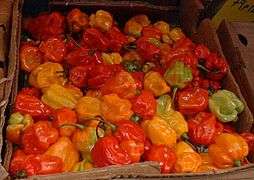 Scotch bonnet (C. chinense) in a Caribbean market
Scotch bonnet (C. chinense) in a Caribbean market
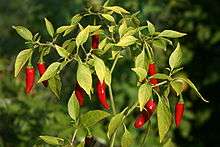 Thai peppers (C. annuum)
Thai peppers (C. annuum) Fresh Indian green chillies in Bangalore market
Fresh Indian green chillies in Bangalore market Piri piri (C. frutescens 'African Devil')
Piri piri (C. frutescens 'African Devil')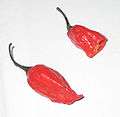 Naga jolokia pepper (bhut jolokia) (C. chinense x C. frutescens)
Naga jolokia pepper (bhut jolokia) (C. chinense x C. frutescens)- C. annuum flower
- C. annum flower close up
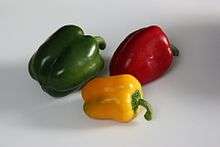 Green, yellow, and red peppers
Green, yellow, and red peppers The flower of red hot bangi pepper, Malaysia
The flower of red hot bangi pepper, Malaysia A small but very hot Capsicum in Malaysia
A small but very hot Capsicum in Malaysia Dried and crunchy Capsicum from Basilicata
Dried and crunchy Capsicum from Basilicata
See also
References
- ↑ "Capsicum L.". Germplasm Resources Information Network. United States Department of Agriculture. 1 September 2009. Retrieved 2010-02-01.
- 1 2 "Species records of Capsicum". Germplasm Resources Information Network. United States Department of Agriculture. Retrieved 2010-06-23.
- ↑ Wells, John C. (2008), Longman Pronunciation Dictionary (3rd ed.), Longman, p. 123, ISBN 9781405881180
- ↑ Oxford English Dictionary, 1st edition, 1888, s.v.
- ↑ Online Etymology Dictionary, s.v.
- ↑ Quattrocchi, Umberto (2000). CRC World Dictionary of Plant Names. 1 A-C. CRC Press. p. 431. ISBN 978-0-8493-2675-2.
- ↑ Gil-Jurado, A. T., Il senso del chile e del piccante: dalla traduzione culturale alla rappresentazione visiva in (G. Manetti, ed.), Semiofood: Communication and Culture of Meal, Centro Scientifico Editore, Torino, Italy, 2006:34–58
- ↑ Latham, Elizabeth (8 February 2013). "Capsicums at your table". Nelson Mail. Retrieved 19 April 2013.
- ↑ "Growing Peppers: The Important Facts". GardenersGardening.com. Archived from the original on 27 January 2013. Retrieved 10 January 2013.
- ↑ https://www.rhs.org.uk/advice/grow-your-own/vegetables/chilli-pepper
- 1 2 Walsh, B.M.; Hoot, S.B. (2001). "Phylogenetic Relationships of Capsicum (Solanaceae) Using DNA Sequences from Two Noncoding Regions: The Chloroplast atpB-rbcL Spacer Region and Nuclear waxy Introns" (– Scholar search). International Journal of Plant Sciences. 162 (6): 1409–1418. doi:10.1086/323273. Retrieved 2007-12-20.
- ↑ Heiser Jr, C.B.; Pickersgill, B. (1969). "Names for the Cultivated Capsicum Species (Solanaceae)". Taxon. Taxon, Vol. 18, No. 3. 18 (3): 277–283. doi:10.2307/1218828. JSTOR 1218828.
- ↑ Tewksbury, J.J.; Manchego, C.; Haak, D.C.; Levey, D.J. (2006). "Where did the Chili Get its Spice? Biogeography of Capsaicinoid Production in Ancestral Wild Chili Species" (PDF). Journal of Chemical Ecology. 32 (3): 547–564. doi:10.1007/s10886-005-9017-4. PMID 16572297. Retrieved 2007-12-20.
- ↑ Eshbaugh, W.H. (1970). "A Biosystematic and Evolutionary Study of Capsicum baccatum (Solanaceae)". Brittonia. Brittonia, Vol. 22, No. 1. 22 (1): 31–43. doi:10.2307/2805720. JSTOR 2805720.
- 1 2 Ballard, R.E.; McClure, J.W.; Eshbaugh, W.H.; Wilson, K.G. (1970). "A Chemosystematic Study of Selected Taxa of Capsicum". American Journal of Botany. American Journal of Botany, Vol. 57, No. 2. 57 (2): 225–233. doi:10.2307/2440517. JSTOR 2440517.
- ↑ Pickersgill, B. (1971). "Relationships Between Weedy and Cultivated Forms in Some Species of Chili Peppers (Genus capsicum)". Evolution. Evolution, Vol. 25, No. 4. 25 (4): 683–691. doi:10.2307/2406949. JSTOR 2406949.
- ↑ Eshbaugh, W.H. (1975). "Genetic and Biochemical Systematic Studies of Chili Peppers (Capsicum-Solanaceae)". Bulletin of the Torrey Botanical Club. Bulletin of the Torrey Botanical Club, Vol. 102, No. 6. 102 (6): 396–403. doi:10.2307/2484766. JSTOR 2484766.
- ↑ van Zonneveld M, Ramirez M, Williams D, Petz M, Meckelmann S, Avila T, Bejarano C, Rios L, Jäger M, Libreros D, Amaya K, Scheldeman X (2015). "Screening genetic resources of Capsicum peppers in their primary center of diversity in Bolivia and Peru". PLoS ONE. 10 (9): e0134663. doi:10.1371/journal.pone.0134663.
- ↑ Zamski, E.; Shoham, O.; Palevitch, D.; Levy, A. (1987). "Ultrastructure of Capsaicinoid-Secreting Cells in Pungent and Nonpungent Red Pepper (Capsicum annuum L.) Cultivars". Botanical Gazette. 148 (1): 1–6. doi:10.1086/337620. JSTOR 2995376.
- ↑ Stewart Jr, C.; Mazourek, M.; Stellari, G.M.; O'Connell, M.; Jahn, M. (2007). "Genetic control of pungency in C. chinense via the Pun1 locus". Journal of Experimental Botany. 58 (5): 979–91. doi:10.1093/jxb/erl243. PMID 17339653.
- ↑ "The Plant List".
- ↑ "Tropicos".
- ↑ Deyuan Yang; Paul W. Bosland. "The Genes of Capsicum" (PDF). HortScience.
- ↑ Kim, Seungill; Park, Minkyu; Yeom, Seon-In; Kim, Yong-Min; Lee, Je Min; Lee, Hyun-Ah; Seo, Eunyoung; Choi, Jaeyoung; Cheong, Kyeongchae (2014-03-01). "Genome sequence of the hot pepper provides insights into the evolution of pungency in Capsicum species". Nature Genetics. 46 (3): 270–278. doi:10.1038/ng.2877. ISSN 1061-4036.
- ↑ Institute, The Chile Pepper. "NMSU Cultivars - The Chile Pepper Institute". www.chilepepperinstitute.org. Retrieved 2016-01-28.
- 1 2 "FAOSTAT". faostat3.fao.org. Retrieved 2016-04-07.
- ↑ Mason, J. R.; N. J. Bean; P. S. Shah; L. Clark Shah (December 1991). "Taxon-specific differences in responsiveness to capsaicin and several analogues: Correlates between chemical structure and behavioral aversiveness". Journal of Chemical Ecology. 17 (12): 2539–2551. doi:10.1007/BF00994601.
- ↑ Norman, D. M.; J. R. Mason; L. Clark (1992). "Capsaicin effects on consumption of food by Cedar Waxwings and House Finches". The Wilson Journal of Ornithology. 104: 549–551.
- ↑ http://npic.orst.edu/factsheets/Capsaicintech.pdf
- ↑ New Mexico State University – College of Agriculture and Home Economics (2005). "Chile Information – Frequently Asked Questions". Archived from the original on 4 May 2007. Retrieved 17 May 2007.
- ↑ "The Scoville Scale of Hotness - Capsaicin Level". Chiliwonders.com. Retrieved 2013-11-27.
- ↑ "The World's Healthies Foods". Retrieved 23 February 2010.
- ↑ http://bonnieplants.com/products/vegetables/peppers/giant-marconi-pepper
- ↑ http://bonnieplants.com/products/vegetables/peppers/yummy-snacking-pepper
- ↑ http://www.territorialseed.com/product/Jimmy_Nardellos_Pepper_Seed/394
- ↑ http://produceexpress.net/products/produce/item/italian-frying-peppers.html
- ↑ http://www.gardenguides.com/119834-capsaicin-insecticide.html
- ↑ http://www.askgarden.com/when-life-gives-you-peppers-use-this-pepper-jam-recipe/
- ↑ Pankhurst, Richard (1968). Economic History of Ethiopia. Addis Ababa: Haile Selassie I University Press. pp. 193–194.
- ↑ Wainwright, Martin (23 May 2005). "Onions come top for British palates". The Guardian. London. Retrieved 2007-10-30.
- ↑ Unknown, Unknown. "Sri Lankan Cuisine". SBS Food. SBS. Retrieved 7 May 2011.
- ↑ Mitzewich, John. "10 Foods America Gave to the World". About.com Food Guide. About.com. Retrieved 7 May 2011.
- ↑ GRAS FDA
- ↑
External links
| Wikibooks Cookbook has a recipe/module on |
| Wikimedia Commons has media related to Capsicum. |
| Wikispecies has information related to: Capsicum |
| Wikisource has the text of the 1911 Encyclopædia Britannica article Capsicum. |
- Capsicum pepper factsheet from Purdue Guide to Medicinal and Aromatic Plants
- Capsicums: Innovative Uses of an Ancient Crop History, Botany, Breeding, and Pungency. Purdue University, Indiana, U.S.A.
- IBPGR (1985). Solanacaea. International Board for Plant Genetic Resources, Rome, Italy.
- Descriptors for Capsicum (Capsicum spp.) from Bioversity International (PDF, 770 kb)
- Capsicum and Chillies: Commercial Cultivation DPI&F Queensland, Australia.
- Chilli: La especia del Nuevo Mundo (Article from Germán Octavio López Riquelme about biology, nutrition, culture and medical topics. In Spanish)
- Capsicum: Growing Capsicum in India GreenMyLife, India


